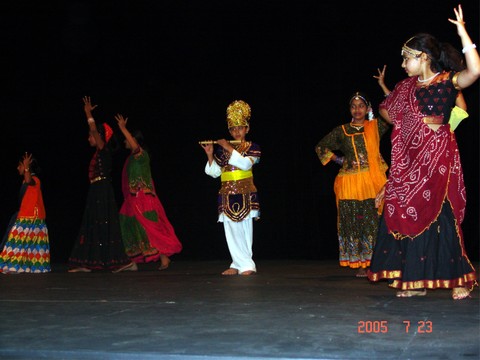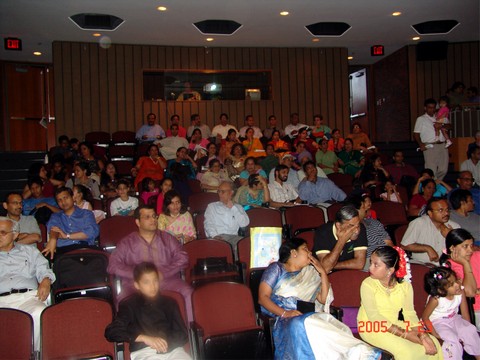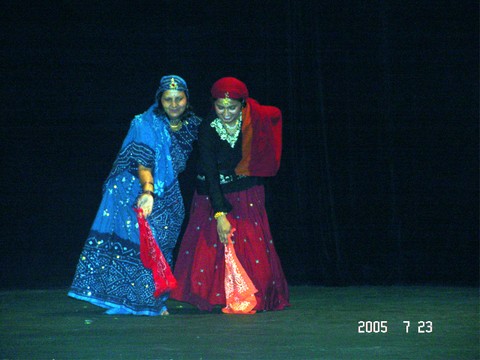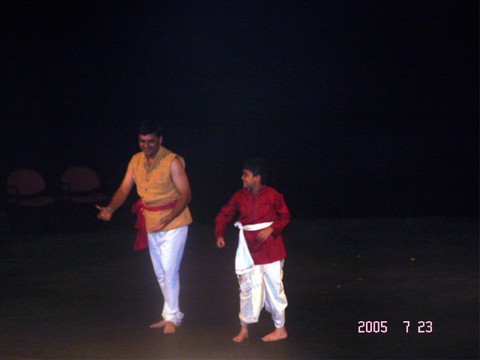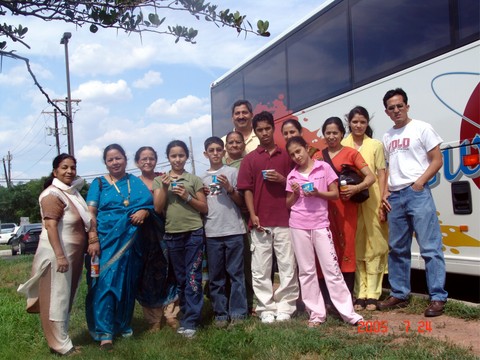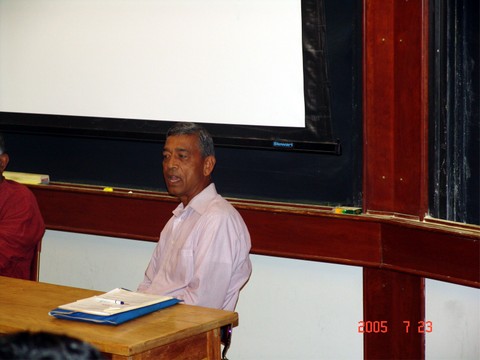Contribute
| The Indian Himalayas Dance To Their Own Tunes In Cambridge |
Rajiv Rawat
08/03/2005
The Uttaranchal Association of North America (UANA) came to
Boston to hold its seventh annual convention at the Massachusetts
Institute of Technology campus on July 23, 2005. The day-long series of
events that included a seminar and colourful evening cultural program,
drew over 250 people from all over the Eastern United States and Canada
to share in celebrating the culture of Uttaranchal, one of India's
Himalayan states. Jack Croucher, a graduate of MIT and native of Cape
Cod, reported on the work of Appropriate Technology India. Formerly a
Peace Corps volunteer assigned to Uttaranchal in the 1960s, Jack has
continued to travel between Massachusetts and the Himalayas on a yearly
basis. During this time, he has been engaged in efforts to improve the
living conditions and livelihood of the people. His projects have
included organic honey collection, silk weaving, and various other
eco-friendly micro-enterprises. These endeavors had been given a small
grant by UANA to further consolidate these efforts and Jack was very
pleased to give an inspiring update on the progress achieved by these
endeavours. Manisha Sharma, an Association for India's
Development (AID) Boston Chapter volunteer, made a detailed
presentation about AID's work and philosophy as well as the two
projects that its partners (Jeevan Saathis) were carrying out in
Uttaranchal. AID is well known among Indo-American college students and
professionals for the high quality of its development work in India. In
her PowerPoint presentation, Manisha talked about various interrelated
aspects of their work and projects inspired by the SEVA (service),
SANGHARSH (struggle for justice) and NIRMAN (creation). She also
provided a detailed biography of their highly skilled partners that
included an eminent Indian woman mountaineer and a joint PhD-MBA degree
holder in environmental management.
UANA has been bringing together families and
individuals for such events since 1998. This is the second time the
Boston Chapter has hosted the convention, repeating the great success
of the third convention that took place in 2001. The convention was
also a sort of homecoming for the seminar section of the convention, as
it was originally initiated by the Boston chapter also in 2001.
This
year the seminar briefed the audience about the general situation of
Uttaranchal, as well provided a space for various projects and
campaigns to present their work. In his introductory remarks, Jaspal
Singh, one of the Boston organizers, pointed out that in a survey that
was held last year on the occasion of the 4th anniversary of the
formation of the state, a large majority expressed disappointment. Most
of those surveyed saw little change, except for increased pollution,
congestion, crime, and corruption that has accompanied rapid
development. However, Jaspal also described three positive outcomes
including the formation of a smaller government closer to its people, a
literary renaissance in the regional Garhwali and Kumaoni dialects, and
drive amongst the people to take advantage of the fresh beginning
afforded by statehood and its affirmation of a regional identity.
Rajiv
Rawat, a graduate student at York University, Toronto, Canada, gave the
first presentation of the day on the Nanda Devi Campaign. He showed a
video he had put together over the past year on the local people's
struggle for sustainable livelihoods in the park lands surrounding the
Himalayan peak of the same name. He also encouraged the audience to
visit the web site www.nandadevi.org
that he had also designed to support the campaign. Rajiv was one of the
lead organizers of the previous 2001 convention in Boston and had
returned to the US for the expressed purpose of participating in this
seminar.
Rounding out the presentations,
Dr. R.S. Bakhuni, a director of UANA from Ohio, gave a report on his
educational project called GYAN. The aim of the project was to provide
training to the children of his village and other neighbouring villages
that would enable them to compete with the children from big cities.
While small scale, his project has been funded almost entirely by his
own considerable out-of-pocket expenses, which has included the
building of a school centre and the paying of salaries of qualified
school teachers.
On the whole, these presentations generated a
lot of interest and discussion amongst the participants and their
friends. Meanwhile, other convention attendees had the option to go on
campus tours of Harvard University and the Massachusetts Institute of
Technology. Others still took in the various sights of Boston. In the
afternoon, Mike Dwan and Namrata Kaur led a workshop on Bhangra at the
cultural program auditorium which was a success for both chidren and
adults. This was followed up by the setting up of exhibits and displays
of various projects and organizations such as the Nanda Devi Campaign,
AID, Child, Relief, & You (CRY), and Gangadham, a commercial theme
park venture in the sacred city of Hardwar.
The evening cultural
program itself was a great success with children storming the stage to
perform both traditional Himalayan dances and more contemporary
Bollywood flavored numbers. Hosted by Pushp Kumar, the coordinator of
the Boston chapter for the last four years, the program boasted almost
four hours of acts, the majority from the New England and New York/New
Jersey/Pennsylvania Tri-State regions. Gorgeously dressed in a diverse
variety of costumes, girls also dominated the show with their
choreographed dance moves. By the end of the evening, the
audience had joined the dancers on stage, bringing to an end one of
UANA most successful conventions thus far.Bollywood Cafe of Lexington
catered the event, while decorations were proved by Alankar Decors of
Northboro.
You may also access this article through our web-site http://www.lokvani.com/
